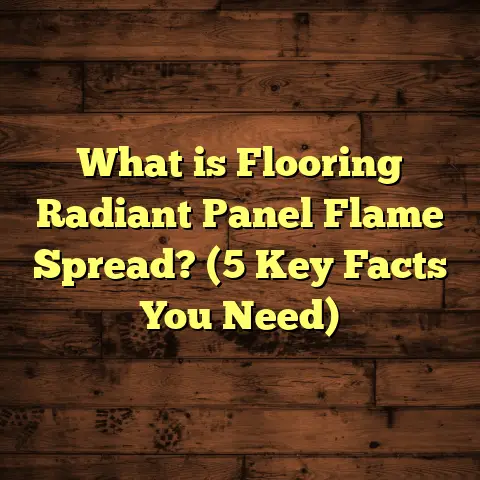What is Cheaper: Stone Flooring or Deck? (5 Key Cost Factors Revealed)
I still remember the first time I stepped onto a floor made entirely from fossilized stone tiles. The surface was cool underfoot, rough yet polished in places, and the patterns told stories that stretched back millions of years. It felt like walking on living history. That experience stuck with me because stone flooring carries a kind of permanence and raw beauty that’s hard to match. On the other hand, I’ve poured my sweat into building decks that turn backyards into cozy retreats — warm wood under your feet, the gentle creak of planks, and the way sunlight filters through trees overhead. Both stone flooring and decks have their own appeal, but if you ask me, the real question everyone wants answered is: which one costs less? Stone flooring or deck?
That’s a question I get asked at least once a week in my work as a flooring contractor. And while you might expect a simple answer, the reality is layered. To help you figure out what fits your budget and needs best, I’m going to walk you through the five key cost factors that make all the difference.
What is Cheaper: Stone Flooring or Deck? (5 Key Cost Factors Revealed)
When it comes down to dollars and cents, I’ve learned from years of hands-on work that the decision between stone flooring and decks depends on several variables. Let me share what I’ve seen through my projects, what the numbers say, and how you can make a choice that won’t haunt your wallet later.
1. Material Costs: The Starting Point for Your Budget
Most people start by looking at material prices, and that makes sense. Stone and deck materials vary widely depending on type, quality, and source.
Stone Flooring Materials
Natural stone flooring options include granite, marble, slate, travertine, limestone, and sandstone — each with its own price range. For example:
- Granite: $15–$30 per square foot
- Marble: $20–$40 per square foot
- Slate: $10–$25 per square foot
- Travertine: $15–$30 per square foot
- Limestone: $10–$20 per square foot
These are just material costs; they don’t include installation.
I’ve worked on projects where clients chose exotic stones imported from overseas, which sent costs skyrocketing due to shipping fees. Conversely, sourcing local stone has slashed prices dramatically — sometimes by as much as 30%. I recall a client in the Midwest who used reclaimed limestone from a local quarry; it cost under $10 per square foot and gave their floor a rustic charm.
Natural stone is heavy and dense, so you’re also paying for bulk — that means transportation costs can add up if sources are far away.
Decking Materials
Deck material options are equally diverse:
- Pressure-treated wood: $12–$18 per square foot
- Cedar or redwood: $15–$25 per square foot
- Composite decking: $25–$45 per square foot
- Tropical hardwoods (like ipe): $20–$35 per square foot
Pressure-treated wood is usually cheapest but requires more upkeep. Composite decking has higher upfront costs but lower maintenance later.
One project I managed involved a composite deck where the client was willing to pay more upfront to avoid annual staining and repairs. They ended up saving money over 15 years despite paying nearly double for materials initially.
So what does this mean for your wallet? If you want a budget-friendly option right now, pressure-treated wood decks or locally sourced limestone stone floors could be your best bet.
2. Installation Complexity: Labor Costs Can Surprise You
Material prices are only half the story; installation often eats up a significant chunk of your budget.
Installing Stone Flooring
Stone installation isn’t as straightforward as laying down vinyl or laminate. Stone slabs need precise cutting to fit spaces perfectly. The subfloor must be absolutely level because natural stone is unforgiving — any unevenness can cause cracking.
On top of that, sealing stone to prevent stains or moisture intrusion is critical. This step requires professional-grade sealants applied carefully.
Labor rates for stone floor installation generally range between $8 and $20 per square foot depending on complexity and your location.
I once installed a travertine floor with intricate mosaic patterns for a client’s kitchen. The installation took nearly twice as long as a standard tile job because each piece needed custom cuts and fitting. The labor bill reflected that extra work — nearly $18 per square foot.
If you’re thinking of DIY, keep in mind that mistakes can be costly. Misaligned or poorly sealed stone can lead to expensive repairs down the road.
Deck Installation
Decks come with their own challenges but tend to be less labor-intensive than stone floors.
Building a basic wooden deck involves framing with joists, securing support posts into the ground or concrete footings, then attaching decking boards on top.
Labor rates for deck installation typically fall between $10–$15 per square foot for straightforward designs.
If you want multi-level decks, built-in benches, or complex railings, expect labor costs to rise accordingly.
One thing I’ve noticed is how quickly costs increase when excavation or ground preparation is required for decks — especially in rocky or sloped yards.
In one project where I built a cedar deck on uneven terrain, we had to pour custom concrete footings and level soil first. That prep work added about $3 per square foot to labor.
The takeaway? If you want to keep labor costs down, simple deck designs on flat ground usually cost less than stone floor installation.
3. Maintenance Over Time: The Hidden Costs
Upfront price isn’t everything. How much will you spend maintaining your floor or deck over the years?
Stone Floors
Stone floors are famously durable and low maintenance. Sealing every few years keeps them looking fresh and prevents stains or moisture damage.
Sealing costs run about $0.50 to $2 per square foot every 3-5 years depending on stone type and traffic levels.
If you choose polished marble or softer stones like limestone, they may scratch easier or need occasional polishing.
I’ve had clients whose stone floors have lasted decades with just minor maintenance — no sanding or refinishing needed like wood floors require.
Wood Decks
Wood decks require regular care — usually annual cleaning followed by staining or sealing every 2-3 years to protect against rot, sun damage, and insects.
Depending on deck size, staining costs range from $500 to over $1,000 each time.
If ignored, wood decks can deteriorate quickly, leading to costly repairs or full replacement within 10-15 years.
Composite Decks
Composite decking reduces maintenance time and costs substantially since it resists rot, decay, and insect damage better than natural wood.
You’ll still want periodic cleaning to remove dirt and mold but no need for staining or sealing.
Over 20 years, composites often save homeowners money compared to wood decks due to fewer upkeep expenses.
I once helped a family calculate maintenance savings for composite versus cedar decks over 25 years — composites came out roughly 40% cheaper when factoring in labor and materials for upkeep.
4. Durability and Lifespan: How Long Will Your Investment Last?
This is where things get interesting because durability directly impacts overall cost-effectiveness.
Stone Flooring Lifespan
Stone floors can last decades or even centuries if installed correctly and maintained properly.
Historical buildings with original stone floors dating back hundreds of years still show little wear — proof of stone’s longevity.
Even softer stones like travertine can last 50+ years with good care.
This means your upfront investment spreads out over many decades without needing replacement.
Wood Deck Lifespan
Wood decks generally last 10-20 years depending on wood type and maintenance quality.
Pressure-treated pine tends to have the shortest life span (about 10-15 years), while cedar and redwood may last closer to 20 years if well maintained.
Many homeowners find themselves replacing boards or railings after just 5-10 years due to weather damage or rot.
Composite Deck Lifespan
Composite decking products often come with warranties ranging from 25-30 years — reflecting their expected lifespan before major repairs or replacement are needed.
They tend to resist fading, warping, and insect damage much better than wood versions.
One of my clients chose composite decking knowing they wouldn’t have to replace it for at least 30 years — which justified the higher initial cost for them.
5. Waste and Preparation: Don’t Ignore These Extras
Beyond materials and labor, there are hidden cost elements like waste factors and site prep that can catch homeowners off guard.
Waste Factor
Stone cutting produces waste because slabs rarely fit perfectly without trimming edges or discarding damaged pieces.
Typical waste factors for natural stone range from 10-15%.
Decking materials usually have lower waste — around 5-7% for wood planks due to cutting lengths but less overall scrap compared to stone slabs.
Using tools like FloorTally helps me estimate these waste percentages accurately so clients aren’t surprised by extra materials needed.
Site Preparation
Stone floors need an extremely flat surface — sometimes requiring concrete leveling or subfloor reinforcement which adds $1-$3 per square foot depending on condition.
Decks require sturdy supports — posts set into ground or concrete footings to prevent shifting. This often involves digging, pouring concrete piers, or grading soil which can add significant prep costs.
One project involved building a deck on sloped terrain needing retaining walls — prepping the site ended up costing nearly as much as materials!
Proper preparation is essential for longevity but don’t forget to factor these costs into your budget early on.
Real Data from My Projects: A Closer Look at Costs
Let me share some real-world figures from recent projects I handled so you get a clear picture:
| Project Type | Material Cost (per sq.ft.) | Labor Cost (per sq.ft.) | Waste Factor | Maintenance Cost (annual avg.) | Expected Lifespan |
|---|---|---|---|---|---|
| Natural Stone Floor | $20 | $15 | 12% | $0.50-$2 every 3-5 years | 50+ years |
| Pressure-Treated Deck | $14 | $12 | 7% | Staining ~$500 every 2-3 years | 10-15 years |
| Composite Deck | $35 | $13 | 5% | Minimal cleaning | 25-30 years |
From these numbers alone, you can see how material plus labor quickly adds up for stone floors but gives you decades of use. Pressure-treated decks are cheaper initially but need regular maintenance which adds ongoing costs. Composite decks cost more upfront but balance durability with low upkeep expenses nicely.
Using FloorTally: How I Calculate Accurate Estimates
Budgeting flooring projects accurately can be tricky because so many variables affect final cost. Early in my career, I used rough estimates based on experience but found this often led to unexpected expenses later on.
That’s why I started using FloorTally — an online tool that helps me get precise cost breakdowns based on local market rates for both materials and labor.
I input project dimensions, choose flooring type (stone or deck), add waste factors it suggests automatically based on material, then get an itemized cost report including prep work and maintenance projections.
This saves me hours of back-and-forth with suppliers and contractors plus reduces guesswork significantly. My clients appreciate seeing transparent estimates before making decisions — no surprises later!
For example, FloorTally once flagged high waste factors in a marble floor project I hadn’t accounted for initially — allowing me to advise the client early about budget adjustments needed. That kind of insight can save thousands in unexpected costs.
Personal Stories From My Workbench
One memorable project was for a couple building their dream home in Colorado. They were torn between installing a limestone floor indoors or building a cedar deck outside their kitchen doors. Their budget was tight but they wanted quality that would last years without constant upkeep.
We ran numbers using FloorTally together:
- Limestone floor material + installation: ~$40k total
- Cedar deck material + installation: ~$25k total plus ongoing staining costs
They decided on the deck after weighing initial savings and outdoor lifestyle benefits but planned to add stone flooring later when budget allowed.
On another job in Florida, a homeowner chose composite decking due to high humidity causing rapid wood decay nearby decks had suffered. The higher price paid off long-term with little maintenance needed even after hurricanes rolled through two seasons later.
These examples highlight how personal preferences combined with local climate affect your best value choice beyond just sticker price alone.
Frequently Asked Questions About Costs
Q: Can I save money by doing installation myself?
A: Installing decks yourself can save labor fees but requires carpentry skills and tools. Stone floor DIY is not recommended due to precision cutting needs—mistakes get expensive fast.
Q: Are there cheaper alternatives to natural stone?
A: Yes! Porcelain tile mimics stone look at lower price points ($5-$15/sq.ft.) but lacks the same natural durability feel. Engineered stone products also exist with varying costs.
Q: How do seasonal changes affect deck longevity?
A: Wood decks expand/contract with temperature changes causing warping/cracking if not maintained properly. Composite decks handle weather fluctuations better overall.
Q: What about environmental impact?
A: Locally sourced stone minimizes transport emissions while sustainably harvested wood or recycled composites reduce ecological footprint too—important if you want green options.
Wrapping Up My Thoughts On Costs and Choices
Choosing between stone flooring and decks isn’t just about comparing prices per square foot. It’s about understanding:
- How material costs vary widely by type and sourcing
- How labor complexity impacts installation fees heavily
- How maintenance adds recurring expenses over time
- How lifespan differences influence long-term value
- How waste factors and site prep create hidden budget demands
Each factor shifts the balance depending on your project specifics—location, climate, design preferences—and personal priorities like durability versus upfront savings.
If you want quick budgeting help tailored to your exact space dimensions and local prices, let me know—I’ll help plug numbers into FloorTally so you see clear comparisons side-by-side before committing cash or time blindly.
Are you leaning toward a sleek stone floor with that ancient feel underfoot? Or does an inviting wooden deck calling your name more? Either way, understanding these five cost factors deeply will help you make a choice you feel good about—for now and years down the road!
If you want personalized advice based on your project details, just ask—I’m here to help!





